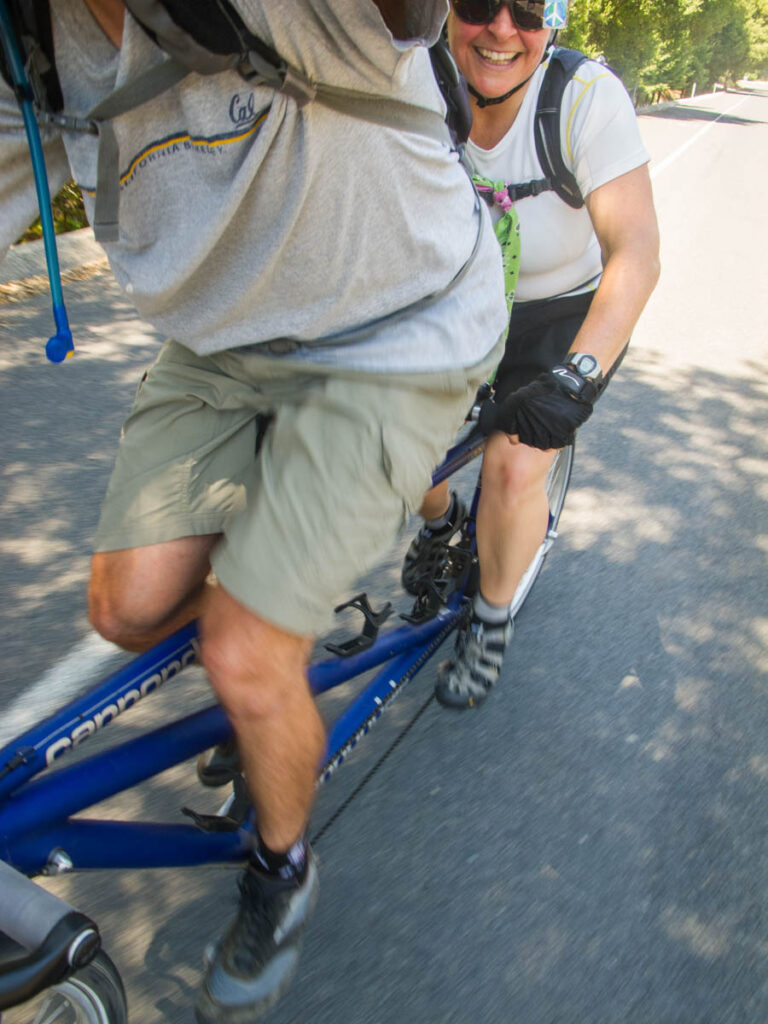Some claim bicycling to be the most efficient (power output per distance covered) movement known, and while that may be hard to prove, it’s certainly close to true. A cyclist using proper gearing and cadence can ride continuously for hours; top racing cyclists can average 25 MPH over hilly courses of 150 to 200 miles, and Race Across AMerica participants cross the country in about 8 days (and that includes all rest stops and sleep). These cyclists are in top physical condition, but it is proper use of the bicycle that allows them to accomplish these feats.
Unfortunately, there are few places where people learn how to access this efficiency. They are taught “how to ride” by their parents–that is, how to sit on a bike seat and move the pedals–but they know little about how to use their bicycle effectively. They ride with cadence too low and gearing too high and get frustrated when they tire out quickly. Most people have the impression that cycling is hard work, because this kind of cycling is hard work and this kind of cycling is all they know. But proper cycling can be sustained for hours by anyone in reasonable physical condition.
The two most important concepts are those of gearing and cadence (which are closely related). “Cadence” is a measure of pedal revolutions per minute, and the purpose of gearing is to keep cadence within a specified range. Just as a car’s gears are designed to keep the engine’s RPM between 2000 and 5000 (or whatever), your bike’s gears are designed to keep the engine’s RPM (that is, your cadence) between 70 and 100. Above 100 RPM you are wasting energy turning the pedals too fast, and below 70 RPM you will burn out your muscles and bonk. Low cadence is also the biggest cause of joint injuries on bikes; the added strain on tendons and ligaments, especially in the knee, is significant.
Most untrained cyclists keep their cadence between 40 and 60 RPM for reasons they probably don’t understand but which I find quite interesting. Our bodies have been evolutionarily optimized for three different modes, loosely classifiable as walking, running, and climbing. Walking is done at low cadence with low muscle force, running at high cadence with high muscle force but low muscle “stroke” (that is, a small range of motion), and climbing (that is, going uphill or traversing other uneven surfaces) at low cadence with high muscle force and high muscle stroke. The bicycle, by supporting the rider’s weight, allows the body to operate in a fourth mode; at high cadence with low muscle force and high muscle stroke. This is unnatural to our bodies; low muscle force is associated with a walking cadence of about 120 paces per minute, or 60 RPM, and in the absence of instructions to the contrary this is the cadence our body assumes. It is not difficult to train your body to operate at 80 RPM, but it does take an effort of will; an effort many cyclists never even know to make.
The reason higher cadence is more effective has to do with the way our muscles work. There are two different chemical reactions our muscles can use to produce power: aerobic and anaerobic. Aerobic reactions use glucose and oxygen from the bloodstream, and can be continued for as long as there is glucose and oxygen in the bloodstream. Anaerobic reactions use glycogen, which is stored in limited supply in the muscles, do not use oxygen from the bloodstream (hence the name), and produce lactic acid as a byproduct. The supply of glycogen in the average fit person’s muscles is enough to last for about 10 minutes; when it is gone, it is gone for the day. Once your glycogen stores are gone, you are bonked; you will be able to continue riding flats at 10-12 MPH, but you will have no energy to handle headwinds or hills, and you will not be having any fun. Therefore, a cyclist interested in riding for more than 10 minutes should jealously guard his stored glycogen by keeping his cadence high.
If you are accustomed to a lower cadence, pedaling at 80 RPM will probably feel wrong. You will probably feel like you’re not doing as much work–because you’re not! Your speed may drop somewhat but your range will increase dramatically, as will your enjoyment of cycling. You will finish your rides feeling tired but relaxed, free of pain, and ready to ride again tomorrow.
A note for the unicyclists out there: Typical unicycle cadences are quite a bit higher than bike cadences; 150 RPM is common, and fast riders regularly top 200 RPM. These cadences are possible because unicycle cranks are shorter than bike cranks; bike cranks are rarely shorter than 170mm, while unicycle cranks are often 125mm or shorter. The shortness of the cranks reduces the distance your feet have to move, which increases the feasible cadence. Spinning short cranks at high cadence is inefficient, but since most unicycles lack gearing, high cadence is the only way to get high speed.
